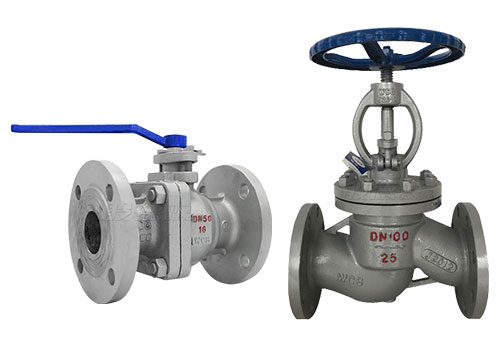The difference between ball valve and globe valve
Posted by Bundor valve
Ball valve and globe valve are two different types of valves, but some people still don't know the difference between the two valves. This article will take you to understand the difference between ball valve and globe valve.

Difference 1: Definition

Difference 1: Definition
- Globe valve, also known as cut-off valve, is a mandatory sealing valve, so when the valve is closed, pressure must be applied to the valve disc to force the sealing surface not to leak.
- The ball valve is a valve in which the opening and closing parts (balls) are driven by the valve stem and rotate around the axis of the ball valve.
- When the medium of the globe valve enters the valve from below the valve disc, the resistance that the operating force needs to overcome is the friction force between the valve stem and the packing and the thrust generated by the pressure of the medium. The force to close the valve is greater than the force to open the valve. , so the diameter of the valve stem should be large, otherwise the valve stem top bending failure will occur.
- Ball valves can be used for fluid regulation and control. Among them, the hard-sealed V-shaped ball valve has a strong shear force between the V-shaped ball core and the metal valve seat of hard alloy surfacing, which is especially suitable for fibers and tiny solids. particles, etc. The multi-port ball valve on the pipeline can not only flexibly control the confluence, diversion, and switching of the flow direction of the medium, but also can close any channel and connect the other two channels. This type of valve should generally be installed horizontally in the pipeline.
- As one of the most important shut-off valves, the globe valve plays an important role in the aerospace field. As an important component of aerospace equipment, globe valve realizes the functions of medium conveying, cutoff and adjustment, and its sealing performance directly affects the safe and reliable operation of aerospace equipment. The study of the influencing factors and influence rules of the sealing characteristics of typical globe valves has guiding significance for the structural design of the valve sealing pair, thereby improving the sealing performance and reliability of the valve.
- Ball valves are widely used in petroleum refining, long-distance pipelines, chemical industry, papermaking, pharmaceuticals, water conservancy, electric power, municipal administration, steel and other industries, and occupy a pivotal position in the national economy. It has the action of rotating 90 degrees, and the cock body is a sphere with a circular through hole or channel passing through its axis.
- According to the direction of the channel, the globe valve can be divided into: straight-through globe valve, straight-through globe valve, angle-type globe valve and plunger-type globe valve. According to the application, it can be divided into: fluorine-lined globe valve, needle valve, cryogenic globe valve, plunger valve, insulating jacket globe valve, forged steel globe valve, oxygen-specific globe valve, bellows globe valve, etc.
- The ball valve is divided into bypass valve, air valve, pressure relief valve and drain valve according to the function. According to the classification of transmission, it is divided into pneumatic ball valve, electric ball valve, hydraulic ball valve, gas-hydraulic ball valve, electro-hydraulic ball valve, turbine transmission ball valve. According to the classification characteristics, it is divided into floating ball valve, fixed ball valve, orbital ball valve, V-shaped ball valve, three-way ball valve, stainless steel ball valve, cast steel ball valve, forged steel ball valve, ash discharge ball valve, anti-sulfur ball valve, pneumatic ball valve, electric ball valve, card Set of ball valves, welded ball valves, etc.
 简体中文
简体中文 Русский
Русский Español
Español Bundor - Butterfly, Gate, Check, Ball, Globe Valve Manufacturer, Supplier & Distributor
Bundor - Butterfly, Gate, Check, Ball, Globe Valve Manufacturer, Supplier & Distributor
